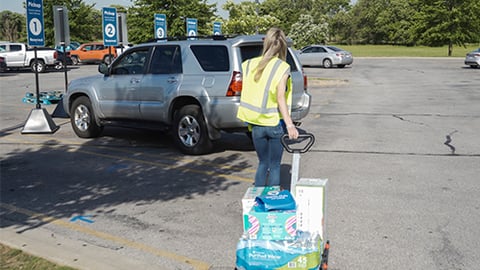The Key to Grocery Pickup Program Success
Demand for pickup and delivery services has skyrocketed since the pandemic, with more shoppers purchasing groceries online now than ever before. Findings from the Brick Meets Click/Mercatus Grocery Shopping Survey in January 2021 indicate that total U.S. online grocery sales reached $9.3 billion, and that pickup and delivery services accounted for 76% of those sales.
Yet, despite this impressive growth, the survey found that overall customer satisfaction had decreased considerably. Intent to repeat purchases with the same service used dropped to 56% overall, with the pickup segment experience seeing the lowest rating compared to delivery and ship-to-home services. And while this can be partially explained by a significant growth in first-time shoppers, the survey results indicate that loyal shoppers were also rating lower satisfaction.
What can grocers do to remedy this and encourage loyalty amongst their shoppers? The answer lies in controlling the entire shopping experience.
Why Grocery Retailers Should Own Their Curbside Pickup Program
With so many online grocery shopping options available to consumers today, keeping them loyal to a brand means offering a valuable, differentiated experience. It’s no longer enough to simply offer curbside pickup or delivery, outsourcing the experience to a third party.
In 2020, Target saw a record-high 20% jump in sales to $94 billion, with online order pickup and delivery accounting for 18% of total sales. Its secret to success? Owning its curbside pickup experience.
When grocers own the pickup experience, they benefit from boosting profitability, gaining control over the customer experience, increasing shopper loyalty and being able to scale the program to meet demand.
- Boosting profitability: Leveraging optimized pick technology to carry out multi-order wave or zone picking, grocers can fulfill more orders per hour with fewer employees. According to our research, retailers using this strategy have seen labor costs decrease by 30% and an increased profit of $10K per store, per year (for stores averaging 70+ online orders per week).
- Gaining control: When retailers own the pickup program, they have full visibility into the customer experience to ensure service is meeting their brand standards. They also gain access to key success metrics that helps them continually improve the program.
- Increase shopper loyalty: Grocers need to give shoppers a reason to choose grocery pickup with them over their competitors. By owning the program, grocers can not only control pickup experience, but can also use geolocation and communication technology to make that order handoff experience seamless. Retailers leveraging these technologies have been able hand off orders to shoppers within 2 minutes of arrival at curbside.
- Scale your program: With increased demand for curbside pickup services, time slot availability is critical to shoppers. When retailers optimize fulfillment for their pickup program with the technologies and pick methods mentioned above, their stores can fulfill more orders per hour, opening up more coveted timeslots to customers.
With the right grocery e-commerce partner, grocery retailers can own their pickup experience and leverage these key technologies that will help them expand their pickup programs and build lasting shopper loyalty. This is the way to get ahead of what’s next in grocery e-commerce.




